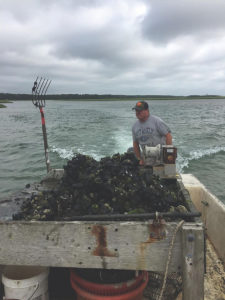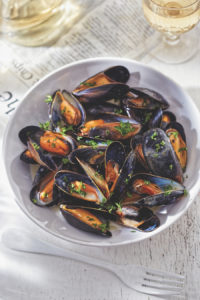
EASTHAM — Mussels are a wild fishery on Cape Cod. That is, if you’re eating a locally harvested mussel, nature did the planting and cultivation. Some are wondering if shellfish growing might make sense here as part of a growing aquaculture industry.
The Outer Cape’s mussel fishery is small. For those with a commercial shellfish permit in Eastham, the catch limit is ten 60-pound bags per day, but Andrew Morgan, a shellfisherman here since 1987, said he hasn’t reached those numbers in years.
“The past few years I’m lucky if I could get 90 pounds in five to six hours,” said Morgan, who owns Native Cape Cod Shellfish.
Morgan is a licensed wholesaler to local restaurants and markets and sells at his own seasonal spot in the Aquarium Mall in Provincetown, too. He harvests wild mussels mainly out of Nauset Estuary, and he may be the only one in Eastham still running a commercial mussel operation. Nicole Paine, Eastham’s shellfish constable, said no one harvests mussels on their aquaculture sites in town.
Paine said that, besides Morgan, three others have commercial licenses to harvest mussels in Eastham: Luther Eldredge, Timothy Linkila, and Jerry Quigley. The Independent was not able to locate Linkila or Quigley. Eldredge, who is 93 years old, was not feeling up to talking with a reporter.
“I have heard stories, from before my time working here, when mussels were very abundant in the Nauset Marsh system,” said Paine, who was named constable in 2017. The harvest hasn’t been as good in recent years, she said.
Tom Marcotti, shellfish biologist for the town of Barnstable, said that commercial and recreational harvesters compete with predators — worms, starfish, and ducks among them. The starfish uses suction disks on its body to force open mussel shells. And according to the Mass Audubon website, the common eider comes by the tens of thousands to Cape shores in winter, and mussels are an important source of food for them.
Marcotti confirmed the unpredictable nature of the natural set. “We actually have a geographical location called Mussel Point,” Marcotti said. Some years, he said, acres of mussel beds appear, they stick around for a few years, then, just as quickly, the population dwindles.
Where do they come from? “I think there must be massive mussel beds in the canal or the bay that float in and just set,” he said.
Provincetown Shellfish Constable Stephen Wisbauer agreed that mussels are plentiful in Cape Cod Bay.
“Wild mussels have sought deeper water in recent years due to sea temperature rise and this has protected the species from predators to some degree, resulting in huge subtidal beds in the bay,” Wisbauer said. “It is a fishery with good opportunity.”
Mussel harvesting is recreational only in Truro, according to the town’s shellfish constable, Tony Jackett. And while Wellfleet allows commercial shellfishermen to harvest mussels, Constable Nancy Civetta said she does not know of any who do so.
Wellfleet would be an unlikely location for future mussel farming, said Alex Hay, who runs Wellfleet Shellfish Company, the wholesale buyer. “Wherever you have intensive farming of other shellfish, mussels would be the last thing you’d want to introduce,” he said. “Mussels and their filaments have a way of getting all over everything,” and could smother oyster beds and gear, said Hay.
As for ideal growing conditions, Morgan said those brought up from firmer muddy bottom are ideal because they’re not filled with grainy sand and are easier to process. Morgan uses a pitchfork to get them out of the water and then proceeds to pull the beards, or filaments, off the shells. Debearding is a tedious process, Morgan said, but it improves the mollusk’s shelf life.
Hay agreed that Morgan’s hands-on approach is worth it. He said in his company’s early years it was getting mussels from Morgan in Eastham. “Those Nauset mussels are really clean,” Hay said. “They were some of the best I’ve ever had.”
Another factor the market cares about, said Hay, is consistency of size. The ideal mussel is harvested when it is about three inches long, he said. But when they come in bigger, at four or five years old and as many inches long, they’re less appealing. Industry folks have a name for the big ones: “gaggers.”
In spite of the high quality of Morgan’s mussels, Hay no longer buys them. That’s because over time Morgan could not provide enough to meet wholesale demand, Hay said. Producing a steady supply would be another challenge in the quest to develop a market for Outer Cape mussels, he noted.
“I’m not selling milk or bread,” Morgan said, adding that his mussels are more of a boutique item for direct sale to restaurants and local markets. The Nauset Fish Market in Orleans confirmed they sell mussels harvested by Morgan and Eldredge.
Morgan said he doesn’t see increasing his production to change that equation. His approach has been enough to help support his family for three decades, he said.
“I don’t want to sacrifice the romance of what I do for more money,” said Morgan. That romance, he said, is the “dirt under my fingernails and the barnacles on my chin.”

